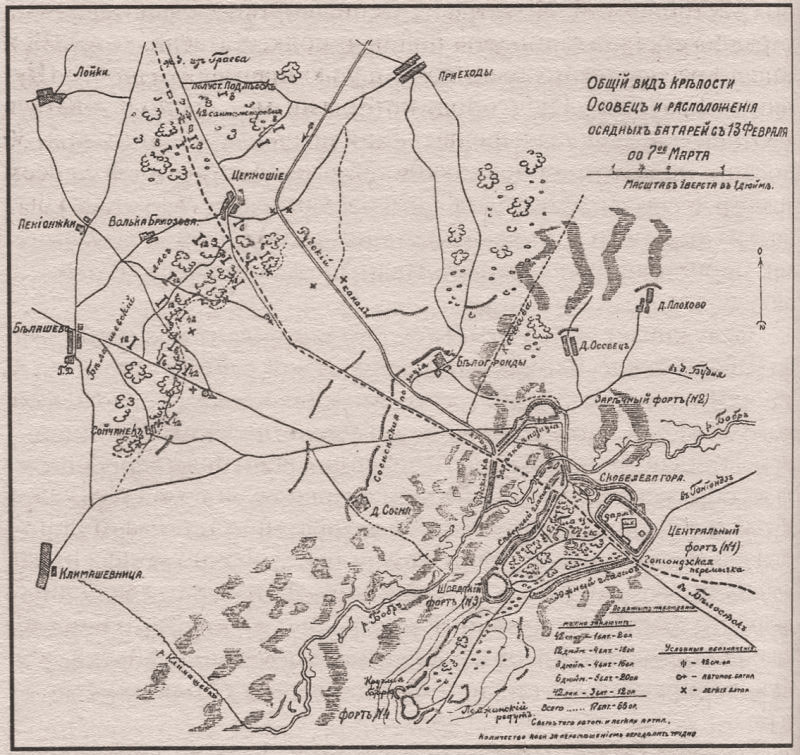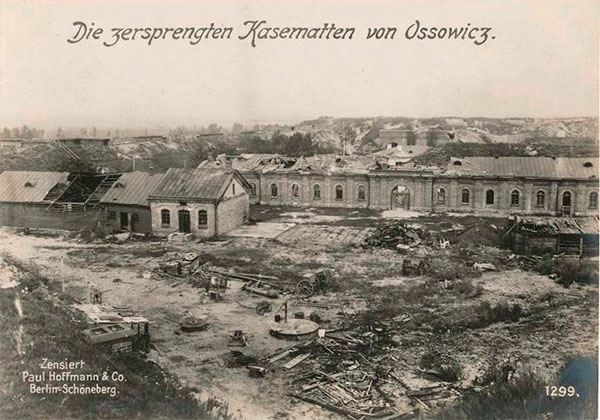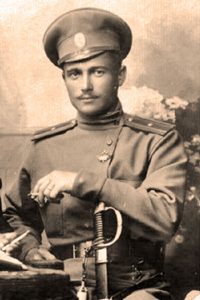Very likely everybody has heard about a feat of the legendary heroes – the defenders of Brest fortress. However it happened that other defenders of another fortress appear practically to be forgotten completely. As they fought in another slightly earlier war, the World War I. It is a war which, as well as exploits of its heroes, has not been permissible to be mentioned because of the ideological reasons for a long time. But there were occasions for heroic deeds of Russian arms there and besides a lot. It is about of the defenders of Osovets fortress.
That battle will go down in history as “the attack of the dead men”.
Memories of German soldier about the attack of the dead men:
The Fortress Osovets wasn’t impressive from a close distance: not high walls, ordinary bricks, surrounded by thickets. From a far distance it did not look like a fortress at all, but like a deserted petit bourgeois school. Captain Schulz, scrutinizing Russian fortification smirked: “German machine will drive over this hillock and won’t even take any notice of it.” I and Sergeant Major Bär shared that mood of the commander. However our hearts were heavy for some reason.
Our regiment was put on high alert at 3:00 o’clock. Soldiers were lined up not far from the railway. Our goal was to attack the right flank of Russian fortification. At 4:00 o’clock punctually the artillery fired. Heavy sounds of gun fire and shell bursts did not die away for half an hour. Then everything stopped as if it was frozen. And “gas fitters” appeared in front of the main entrance of the fortress. So we called the unit of Landwehr which used poison gas to annihilate the enemy. “Gas fitters” began to carry gas cylinders closer to the fortress and pull the hoses. Some hoses were pushed through the apertures that lead under the ground and some hoses were just dropped on the ground. The Fortress was located in the lowland and those efforts were enough to poison the Russians.

“Gas fitters” worked expeditiously. All the work took 15 minutes. Then they turned on the gas. We were ordered to wear gas masks. Sergeant Major Bär said that he had heard the conversation between two “gas fitter” officers – allegedly they determined to use some new kind of gas that could kill very efficiently. They also said, that the Command decided to poison the Russians because, according to the military intelligence reports, they did not have gas masks. “The battle gonna be rapid and lossless,” assured he whether himself or me.
Gas spread all around the lowland quickly. It seemed that there was not a deadly cloud creeping towards the fortress but the ordinary morning mist, albeit very dense. And then out of the mist we heard terrible, bloodcurdling sounds. Our imagination painted dreadful pictures: one person could scream such way only when unknown, inhuman, devilish power would turn him inside out. Glory to Jesus Christ our Lord it did not last for a long time. In about an hour the gas cloud dissipated and Captain Schulz ordered to move forward. Our group reached the walls and threw pre-prepared ladders on them.
It was quiet. The soldiers started to mount. Corporal Bismark was the first who climbed up the wall. Being already on the top he staggered suddenly and nearly fell down but still remained on his feet. Having felt on his knee, he ripped off the gas mask. After that he vomited immediately. Next soldier behaved the same way approximately. He shuddered somehow unnatural, his legs weakened and he knelt down. The third soldier, who perched on the fortification, fell on the Sergeant Major Bär and was deeply unconscious. Bär was kept from falling off the ladder by a miracle and managed to stop that soldier from falling down. I helped Bär lift the soldier on the wall back and appeared on the fortification with the Sergeant Major almost simultaneously.
What I saw down there, in the heart of the fortress, I would never forget. Even some years later I can see the picture, in comparison with which works by great Bosch seem to be comic sketches. There was no gas cloud inside the fortress yet. Practically each part of the parade ground was strewn with dead bodies. They were lying in some maroon mass of which origin there was no need to guess. Mouths of the dead men were open widely, parts of internal organs fell out of them and mucus was flowing. Eyes were bloody or came out entirely. Apparently, while gas flowing, soldiers ran outside of their shelters to inhale salutary air which was not there.
I threw up right in the gas mask. Gastric juice and army stew covered glasses and cut off my airway. I could hardly find the strength and tore away the gas mask. “Oh my God, what is it? What is it?!” somebody said it again and again. All new soldiers pushed us from below and we were forced to come down. Down there we began to move to the center of the parade ground, to the place where the Russian Banner hung. Sergeant Major Bär, who was considered like an atheist among us, kept repeating quietly: “Oh my God, Oh my God, Oh my God…” From the direction of the left flank and the main gate the soldiers of other units, who broke into the fortress, were advancing to the centre of the square. Their state wasn’t better than ours.
On the right-hand side I caught sight of movement. A dead soldier, judging by tab and shoulder straps – Russian Lieutenant, started raising himself on his elbow. Turning his face, rather a bloody mush with escaped eye, he spoke in a hoarse voice, “Platoon, load the guns!” We all, absolutely all the German soldiers, who were in the fortress at that moment, stood paralysed with terror and there were several thousand people. “Platoon, load the guns!” the dead man said again. The bunch of dead bodies, we were going over to our victory, began to stir around of us. Some of ours fainted; some seized their rifles or comrades. And the lieutenant kept moving, rose to his full height and unsheathed the sabre.
“Platoon, forward!” Russian officer croaked with inhuman voice and staggered towards us. And in a moment the whole our victorious army fled. With a cry of horror we rushed to the central entrance. Exactly then it was an exit already. And behind our backs the army of dead men rose to the feet. The dead men grasped our legs, threw us to the ground. They strangled us, beat us by hands, sabred us, thrusted their bayonets into us. They shot in our backs. And we ran on and on, ran filled with awful horror, not helping get up our comrades, sweeping away and pushing those who were running ahead. I can’t remember when I stopped – in the evening of that day or the next one.
Then I found out that dead men weren’t really dead men but only not fully poisoned Russian soldiers. Our scientists discovered that the Russians in the Osovets fortress drank lime flower tea and it helped partly to neutralize the effect of our new secret gas. Maybe they told lies though, those scientists. Also there were rumors that during the storming of the fortress one hundred German soldiers died of broken hearts. While several hundred soldiers more were beaten to death, killed with sabres, shot dead by the Russians risen up from the hell. They were killed by the Russians, who, as they said, nearly everybody died the very next day.
All the German soldiers, participated in that operation, were exempted from military service. Many soldiers have gone mad. Many soldiers, including me, wake up and yell in terror at nights. Because there is nothing more dreadful than a dead Russian soldier.

The siege of the fortress was in 1915 and lasted 190 days. All that time the fortress was shot by German artillery. The Germans rolled even two their legendary “Big Berthas”, which the Russians contrived to put out of action with returned fire.
Then Command of headquarters decided to storm the fortress by poisoning its defenders with gas. On the 6th of August at 4 am acid-green smoke of oxide chlorine flowed towards the Russian positions and reached them in 5 – 10 minutes. The gas wave 12 – 15 metres high and 8 kilometers wide penetrated 20 kilometers deep.
Gas was so toxic that while those several hours even the grass faded and became hard.
Doomed fortress seemed to be already in German hands. German lines approached the trenches. And at that very moment Russian infantry counterattacked them suddenly out of the rich-green chloric smoke. The spectacle was horrific: the warriors with faces wrapped with rags stormed bayonets ahead. They shook because of terrifying cough, literally spit out fragments of lungs on to bloody soldier’s blouses. There were remains of the 13th company of the 226th Zemlyansk regiment, just over 60 people. But they put the enemies in such a state of shock that German infantrymen rushed back without fighting. They trampled down each other, hung down over their own barbed wire fence. From Russian batteries, shrouded by chloric clouds, they were fired by seemingly dead Russian artillery. Several scores of half-dead Russian warriors routed three German infantry regiment! The world military art had never known anything of the kind.

Just the officer, who stirred the soldiers to the attack, was Vladimir Karpovich Kotlinskiy. He was born in Ostrov town of Pskov government. His father was a peasant and came from Verkaliy village, Igumensk uyezd, Minsk government, nowadays the territory of Shatsk Soviet of the settlement, Belarus. Mather’s name is not stated directly in available sources. It is suggested, that she was a telegraphist in Pskov-1 station Nataliy Petrovna Kotlinskaya. It is assumed as well there was at least another child in the family, young Vladimir’s Brother Eugene (1898 – 1968).
After finishing the school in 1913 Vladimir Kotlinskiy passed examination to the Military-topographic school in Petersburg. In summer 1914 after the first course cadets did their standard geodesic training near Rezhets, Vitebsk government.
19th July (1st August) 1914, the day of German declaration of war against Russia is considered as the first day of the World War I. In one month the school graduated cadets ahead of schedule and they were placed to the units. Vladimir Kotlinskiy was awarded with the rank of Second Lieutenant and was attached to the 226 infantry Zemlyansk regiment which became a part of the garrison of Osovets fortress.
Little is known about the details of service of Kotlinskiy before his feat. In the article “The Feat of Pskov resident”, published in 1915 already after his death, it was said as well:
At the beginning of the war just graduated the Military-topographic school young man, Second Lieutenant Kotlinskiy was attached to N regiment. That man seemed not to know absolutely what the apprehensiveness was and even instinct of self-preservation. Already in the last duty of regiment he made himself useful by commanding one of the companies.